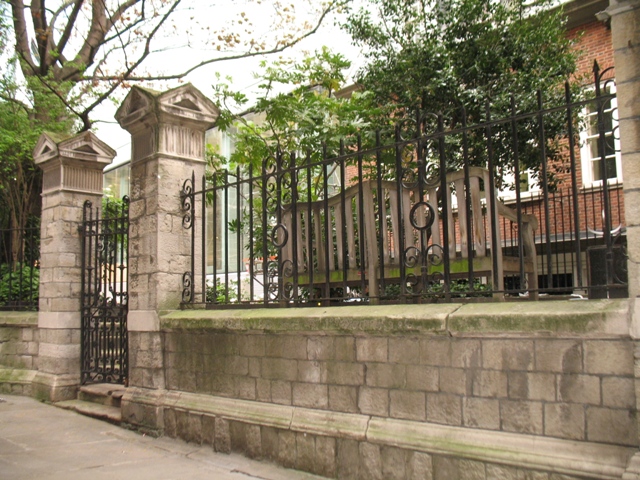St Stephen Walbrook's Churchyard Garden (City of London)
Brief Description
St Stephen Walbrook is the parish church of the Lord Mayor of London. There was once a C7th Saxon church here, itself probably built on the foundations of a C2nd or C3rd temple of Mithras. St Stephen's was originally on the west side of the Walbrook stream, but in 1428 the Lord Mayor purchased land from the Grocers' Company on the east side to build a new, larger church. Destroyed in the Great Fire, the church was rebuilt by Wren, becoming one of his largest parish churches. It was bomb-damaged in 1941 and re-dedicated in 1954. The raised churchyard behind the church is now a garden, shaded by trees and largely paved, with seats and modern sculpture.
Practical Information
- Site location:
- 39 Walbrook, Mansion House
- Postcode:
- EC4N 8BN
- What 3 Words:
- planet.hobby.sentences
- Type of site:
- Private Garden
- Borough:
- City of London
- Open to public?
- Yes
- Opening times:
- Church normally open weekdays 10am-3.30pm
- Special conditions:
- Facilities:
- Events:
- Concerts and events in church, check website for details
- Public transport:
- Tube: Bank (Central, DLR, Northern, Waterloo & City) / Monument (Circle, District); Mansion House (Circle, District)
- Research updated:
- 12/06/2023
- Last minor changes:
- 19/07/2023
Please check with the site owner or manager for latest news. www.ststephenwalbrook.net
Full Site Description
St Stephen Walbrook is the parish church of the Lord Mayor of London. On the site was once a C7th Saxon church, itself probably on foundations of a C3rd Mithras temple preserved in Queen Victoria Street. St Stephen's church, originally on the west side of the Walbrook, is first mentioned c.1096; in c.1100 it was given by Eudo in the reign of Henry I to the monastery of St John at Colchester. In 1428 the Lord Mayor of London purchased land from the Grocers' Company on the east side of the Walbrook to build a new, larger church; this was completed in 1439, and patronage of the church was given to the Grocers' Company in 1474 by Richard Lee, one-time Lord Mayor, who had been granted it by Edward IV. This building was destroyed in the Great Fire and rebuilt by Wren in 1672-79. After the Fire, the parish of the nearby church of St Benet Sherehog in Pancras Lane, destroyed and not rebuilt in 1666, was united with that of St Stephen. St Stephen Walbrook is one of Wren's largest parish churches and according to Pevsner the most majestic, now much crowded in by buildings. The dome was an early attempt at such a structure by Wren. Its spire was added to the square tower in 1713-15 as were square urns on the tower balustrade, and may have been designed by Nicholas Hawksmoor; the design is similar to those of St James Garlickhithe (q.v.) and St Michael Paternoster (q.v.). The architect Sir John Vanbrugh was buried here in the north aisle of the church.
Wren's church suffered bomb damage in 1941 and was re-dedicated in 1954. Further restoration took place between 1978-87 and the church was re-dedicated in 1987, with an altar commissioned from Henry Moore for the church carved in 1972. The Samaritans were founded here in 1953.
The pleasant tree-lined and largely paved raised churchyard garden is tucked behind St Stephen's Church, bounded by a wall topped with iron railings, with access from St Stephen's Row through ornamental gate flanked by fine stone piers, with steps leading up to churchyard garden. The Churchwardens' Accounts of 1577-8 list xij d. 'for cutting the hedges in the Church yeard' and in 1604-5 ij s. 'paid for Cutting the Grasse plot and weeding the Allies in ye Churchyard'.
St Stephen's Churchyard Garden was relandscaped following development works to the adjacent site, and today has paving, seats and a modern sundial. A stone bench commemorates the landscape gardener, Lanning Roper, who redesigned the garden in 1975-82 by Lord Peter Palumbo.
Sources consulted:
B Plummer and D Shewan, 'City Gardens', London, 1992; Simon Bradley & Nikolaus Pevsner, 'The Buildings of England, London 1: The City of London', 1997 (1999 ed.); George Godwin & John Britton 'The Churches of London: A history and description of the Ecclesiastical Edifices of the Metropolis, Volume II', London, 1839; Philip Norman, 'The London City Churches, Their Use, Their Preservation and Their Extended Use', The London Society, (1920s); London Diocesan Advisory Committee for the Care of Churches data; Gerald Cobb 'The Old Churches of London', Batsford, 1942; Kerry Downes, 'A brief history of St Stephen Walbrook' on church website
Further Information (Planning and Conservation)
- Grid ref:
- TQ326810 (532680,181020)
- Size in hectares:
- 0.0297
- Site ownership:
- Diocese of London
- Site management:
- Church
- Date(s):
- medieval; 1672-9; C19th
- Designer(s):
- Listed structures:
- LBI: St Stephen's Church. LBII: Gatepiers to churchyard on St Stephen's Row
- On National Heritage List for England (NHLE), Parks & Gardens:
No- Registered common or village green on Commons Registration Act 1965:
No- Protected under London Squares Preservation Act 1931:
No
Local Authority Data
The information below is taken from the relevant Local Authority's planning legislation, which was correct at the time of research but may have been amended in the interim. Please check with the Local Authority for latest planning information.
- On Local List:
- No
- In Conservation Area:
- Yes
- Conservation Area name:
- Bank
- Tree Preservation Order:
- No
- Nature Conservation Area:
- No
- Green Belt:
- No
- Metropolitan Open Land:
- No
- Special Policy Area:
- No
- Other LA designation:
- Strategic View - Consultation Area
Photos
St Stephen Walbrook Churchyard, April 2011. Photo: W McDougall
Click a photo to enlarge.
Please note the Inventory and its content are provided for your general information only and are subject to change. It is your responsibility to check the accuracy.











